Ageratum: planting, care, growing from seeds
 Ageratum plant belongs to the genus Asteraceae. Its representatives are native to North and Central America, as well as East India. The name of the plant comes from the Latin word “ageratos” which means "ageless", and, in fact, a cut flower of ageratum stays fresh for a long time. In Europe the ageratum became popular in the 19th century, in Russia it is called the "long-flowering".
Ageratum plant belongs to the genus Asteraceae. Its representatives are native to North and Central America, as well as East India. The name of the plant comes from the Latin word “ageratos” which means "ageless", and, in fact, a cut flower of ageratum stays fresh for a long time. In Europe the ageratum became popular in the 19th century, in Russia it is called the "long-flowering".
It is grown in gardens for its fluffy flowers that look like pompoms being collected in dense blue inflorescences. In addition, it is a minimal care plant. There are about 60 species of ageratum.
Description of ageratum flower
Ageratum is a small bush with triangular, oval or diamond-shaped leaves of a juicy-green color with a toothed edge. Upper leaves are alternate, sessile. Middle and lower leaves are opposite and on petioles. Numerous upright pubescent stems reach from 4 inches to 2 ft in height. Flowers are small, fragrant, bisexual, collected in small flowerheads that are from 0.4 to 0.6 inch in diameter forming complex corymbose inflorescences that can be not only blue and purple, but also white and pink. The fruit of ageratum is an elongated wedge-shaped pentahedral seed. Approximately 7,000 small seeds weight 15 gr and retain germination capacity for 3-4 years.
In cold climate zones ageratum is grown as an annual plant as it is a very heat-loving plant. Ageratum looks great on garden and flower beds, it is widely used to create "carpet compositions". Neighbor plants of ageratum are other annuals such as snapdragon, marigold, calendula.
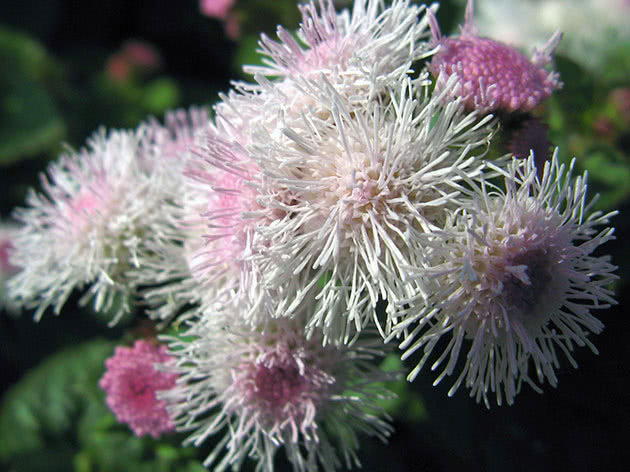
Growing of ageratum from seeds
Sowing of ageratum seeds
As a rule, propagation of ageratum is carried out by the seed method. In the second half of March the seeds of ageratum are sown in the boxes with soil consisting of equal parts of humus, sand and peat. Small seeds are carefully sprinkled with the same soil and covered with glass or foil. Keep the boxes in a room where the temperature is not below 59 ºF, daily allowing access to air. It is very important to keep the soil slightly moist all the time, so do not forget to spray the soil with water as it gets dry. Seedlings germinate usually in a couple of weeks, and when they appear, the cover must be taken away.
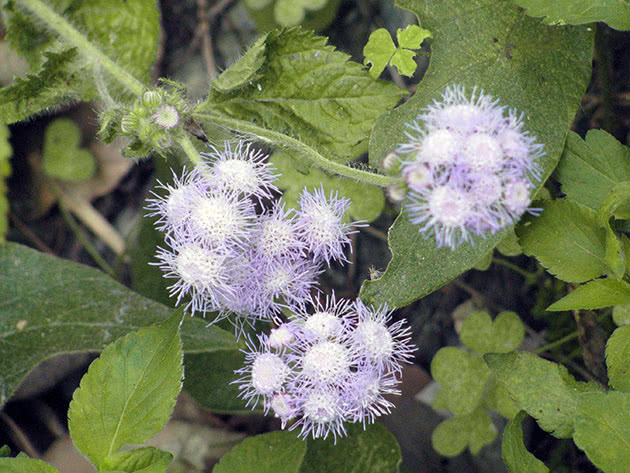
Seedlings of ageratum
When two pairs of true leaves appear, seedlings should be planted out more spaciously. Seedlings of ageratum should be pricked out two times, and during the second pricking each sprout should be planted in a separate pot or cup. The air around the seedlings should be dry, and the soil should be moist. Watering of ageratum is carried out only in the morning. Two weeks before planting the plant should be taken outdoors to get hardened off, but if there is a threat of frost, be ready to take it indoors.
Planting of ageratum
Planting of ageratum in the ground is carried out when the night frosts pass. The site should be protected from drafts and with full sun – if you plant ageratum in the shade, shoots will get elongated, and instead of compact bushes you will get poorly blooming disarranged bushes. The soil should be well drained, nutritious, light and not acidic, although ageratum is not choosy. Before planting you should loosen the soil properly, dig up the holes at a distance of 4-6 inches from each other and plant the seedlings at the same depth as they grew in seedlings or pots. Ageratum will start blooming in two months.
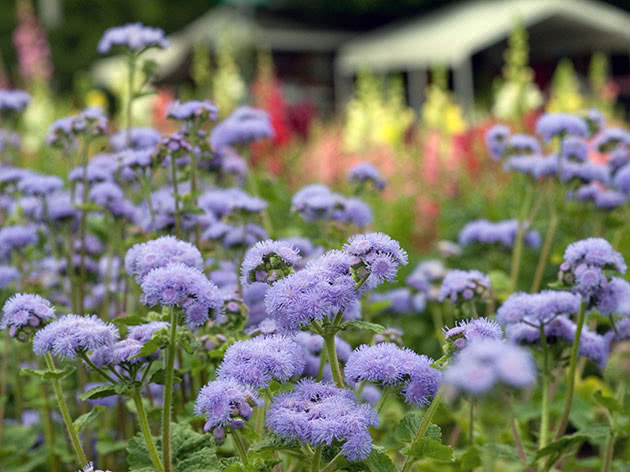
Care for ageratum
Care for ageratum involves watering, fertilizing, loosening of the soil and weeding. Watering of ageratum should be abundant, but not excessive. After watering, you should loosen the soil and remove the weeds. Feed the plant with humic or mineral fertilizers every two to three weeks. Infusion of mullein gives good results, but do not use fresh manure as a fertilizer – the ageratum does not tolerate it. Try not to overfeed the plant, otherwise it will grow profusely, but it will not bloom. Timely remove spent inflorescences. If you want ageratum to bloom abundantly and beautifully, it is necessary to prune it, leaving only a few internodes on the stem. Usually, after such pruning, ageratum grows quickly and blooms more luxuriantly.
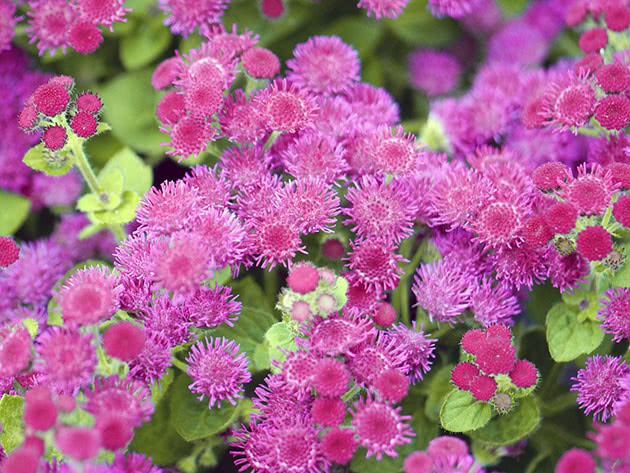
Ageratum after flowering
Before the first frosts, transplant the most beautiful shrubs of ageratum into flower pots and place them in the house, on the balcony or veranda and they will decorate your home until the end of autumn, and maybe even in winter. In March you can make cuttings and root them to plant them in the garden after frosts.
In general, the ageratum is a heat-loving plant that does not tolerate even the mildest winters. Covering will not protect it as well. Therefore, you will have to clean the flowerbed of the remnants of ageratum and plant the new plants next spring.
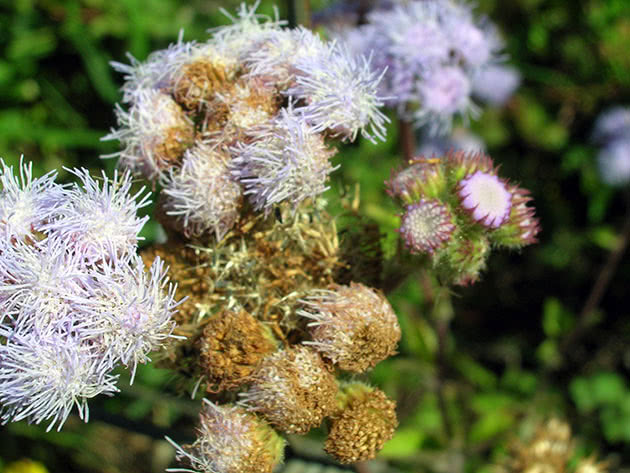
Diseases and pests of ageratum
The weakest point of ageratum is susceptibility to diseases. Most often ageratums suffer from root rot, and there is no escape from this disease. But by taking such measures as using of a light soil substrate for planting of ageratum, controlling of irrigation and regularly loosening of the soil to slow the evaporation of moisture from the soil you can prevent the disease. Ageratum can get affected by the cucumber mosaic and bacterial withering as a result of improper care of the plant.
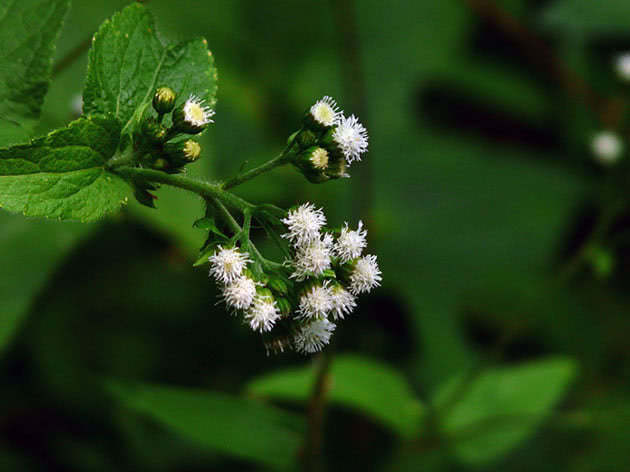
While young plants are indoors or in a greenhouse, they should be protected from spider mites and whiteflies, but if they have appeared, you will have to remove the damaged leaves and treat the plants with insecticides until the insects die. Later, on the flowerbed, cutworms and nematodes can attack ageratum, and you will have to work hard to get rid of them. Therefore, we are repeating the rule: diseases and pests attack the plants when you have been violating the care rules for a long time. If you strictly follow the rules, your plants will easily avoid such troubles.
Species and varieties of ageratum
Since growing of ageratum is not difficult and ornamental effect is quite high, it is not surprising that it is so popular among florists. We will present you a few popular species and the most attractive varieties of ageratum:
White ageratum
reaches up to 8 inches in height, has upright stems, fragrant white flowers.
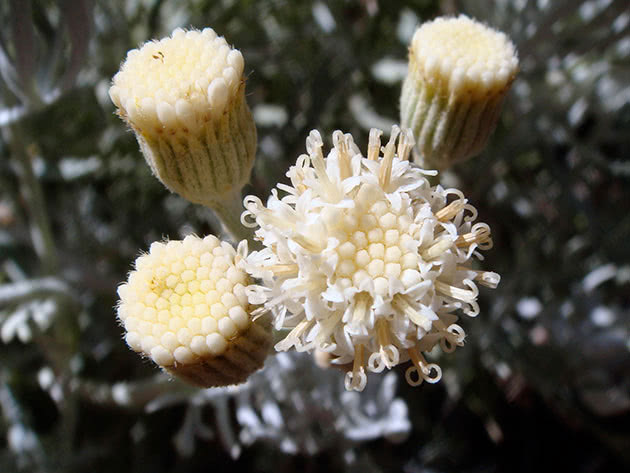
Blue ageratum Blue Mink
is a small branched bush with strong shoots of 8-10 inches in height. Fluffy inflorescences of a gentle blue hue look like a fur of a mink as they cover the bush entirely. The diameter of the inflorescence is 2-3 inches.
Mexican ageratum
or flossflower is a compact ball-like small bush that reaches 6-24 inches in height depending on the variety. Inflorescences are from 1.2 to 3 inches in diameter, consist of flowerheads formed by fluffy flowers. The varieties are:
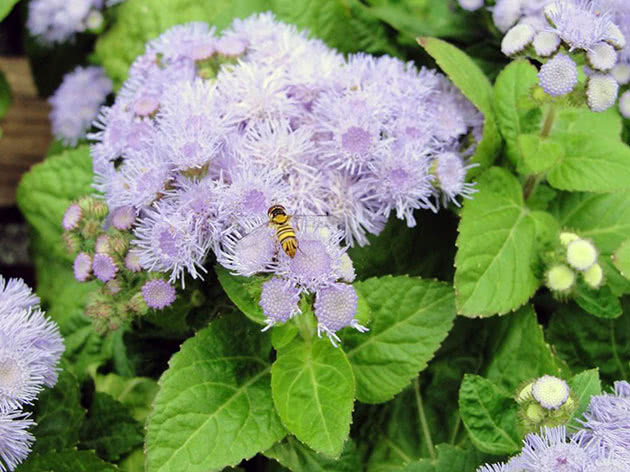
- Alba is a white ageratum with dense inflorescences
- Azur Pearl is a blue ageratum with large inflorescences;
- Fire Pink is a pink ageratum of dark shade with loose inflorescences 1.5-2 inches in diameter and small leaves. The height of the bush is 7.8-11.2 inches;
- Blue Mink is a blue ageratum with the buds of a lilac hue, the leaves are large, the height is 10-11.8 inches;
- Blue Bouquet is a blue ageratum of a very beautiful hue, it is the giant among the ageratums as it reaches a height of 17.7 inches;
- Hawaii variety group is: Royal Hawaii is a dwarf variety, 6 inches tall with purple-violet flowers; White Hawaii is also a dwarf compact variety, only 7 inches high with white flowers;
- Bavaria is 10-11.8 inches high with large loose two-color inflorescences: the center of the flowerhead is light blue, almost white, and around it there are delicate petals of bright blue color.
